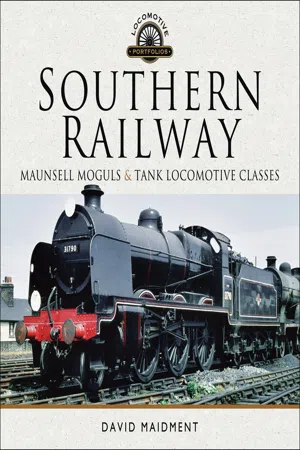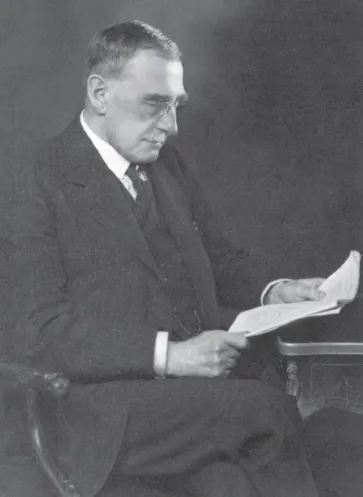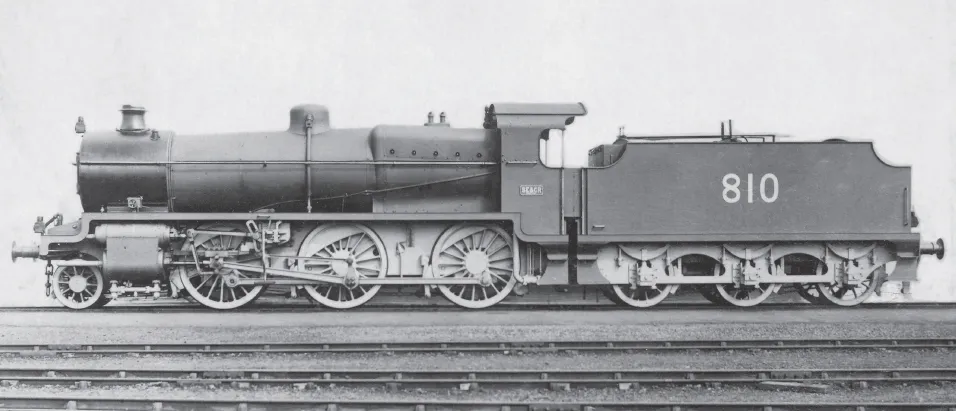![]()
Chapter 1
RICHARD MAUNSELL
Richard Maunsell was born at Raheny, County Dublin, in Ireland on ‘26 May’ 1868. His predecessors were land-owners and were in the legal profession, but from an early age the boy showed his primary interest to be engineering. He was one of a large family and attended a Public School, the Royal School at Armagh, in 1882, before training after pressure from his father for a Law degree at Trinity College, Dublin, in 1886. However, the backbone BA course at the university was followed by all students and he was able to specialise in engineering, and was also to benefit from his solicitor father’s contacts with the Board of the Irish Great Southern & Western Railway, becoming simultaneously a pupil of H.A. Ivatt at its Inchicore Works, before moving to England through connections between Ivatt and Aspinall of the Lancashire & Yorkshire Railway.
Maunsell had a number of basic depot appointments in the Blackpool and Fleetwood District after experience on the design side and during this time was courting Edith Pearson, whom he had met during his contacts with the Aspinall family. However, Edith’s father prevented their engagement until Maunsell was better able to assure him of his career earning prospects, so Maunsell sought a higher paid post and successfully applied to be Assistant District Locomotive Superintendent of the East India Railway based at Jamalpur. The East India Railway was very extensive, the second largest railway in India. Maunsell gained rapid promotion there, and after a spell at Tundla, on the Allahabad-Delhi route, was transferred back to Jamalpur, then as the Principal District Locomotive Superintendent.
He was appointed at the young age of twenty-eight to the post of Assistant Locomotive Engineer and Works Manager at Inchicore in March 1896, and immediately set about the reorganisation and modernisation of the Works. Between 1897 and 1902 the GS&WR increased its network size by 70 per cent through company takeovers, with Inchicore becoming responsible for the replacement and maintenance of the increased locomotive fleet. Richard Maunsell was appointed Locomotive Superintendent on 30 June 1911.
Maunsell’s reign at Inchicore, however, was short-lived, for in 1913 he was approached by the South Eastern & Chatham Railway seeking a replacement for their Locomotive, Carriage and Wagon Engineer, Harry Wainwright, who took early retirement. He was appointed in December 1913 and had the immediate task of reorganising Ashford Works, which could not cope with the workload then placed on it, and the organisation of which had become a mess – Wainwright had been a fine engineer but his management skills, especially in later years, were weak.
Many of Wainwright’s team were nearing retirement age and Maunsell soon assembled a new and very competent team, including James Clayton from Derby and George Pearson and Harry Holcroft from Swindon, although the onset of the First World War restricted their immediate influence. Maunsell was strong enough to bring about significant changes – partly to counter the influence of Hugh McColl, a dour Scot and autocrat who had been allowed to exert undue influence, possibly beyond his competence, especially during Wainwright’s declining years. Maunsell had a major task ahead in managing the Works and the design and construction programme, and the directors recognised his priorities and somewhat belatedly split off the responsibility for managing locomotive and rolling stock performance in traffic.
Richard Maunsell at Ashford, c1914. (G.M.Rial)
In 1914, the Government created the Railway Executive Committee to take charge of the railways during the wartime period, and Maunsell was appointed as Chief Mechanical Engineer to this body. Some of his work involved the overseeing of maintenance of locomotives in Belgium and Northern France, working under ROD auspices and at the end of the war he was awarded the CBE for his services. However, he still found the time to design his prototype locomotives for the SE&CR, the ‘N’ class mogul and the ‘River’ class 2-6-4 express passenger tank engine. Maunsell had been poised to act as the CME of the proposed nationalised railway after the war, but political views changed and the ‘Grouping’ proposed by Sir Eric Geddes, then Minister of Transport, came about under the Railways Act of 1921, implemented on 1 January 1923.
With Robert Urie’s retirement at age sixty-eight, Maunsell was the natural successor as CME of the new Southern Railway, inheriting a fleet of 2,285 steam engines of 115 different classes, with little standardisation. He was a consummate and skilled manager and administrator, and popular with his team and staff. His influence in new steam engine design was circumscribed by the Southern Board’s priority of investment in electrification, restricting money available for the wholesale standardisation of the steam stock as happened on the GWR under Churchward and Collett, and Stanier on the LMS. Maunsell was heavily involved, along with electrical engineers H. Jones and A. Raworth, in the development of rolling stock for the Brighton and Portsmouth electrification, developing the steam-hauled stock he had designed in the mid-1920s. By the time of his retirement, 3,000 coaches of electric stock existed, a tenfold increase from 1923. During this time, the workshops and Maunsell were under great pressure to meet the electrification deadlines and this was achieved despite the stress this caused.
Increasing ill health caused Richard Maunsell to take retirement in 1937, when he was sixty-nine years old. He formally handed over responsibility for the SR Motive Power Department to Oliver Bulleid on 31 October, having had a strong and successful relationship for many years with the Southern’s General Manager, Sir Herbert Walker. He left the railway with 1,852 steam engines of 77 classes and a substantially electrified network, retiring to spend his days involved in the life of his local Parish Church, which he and Edith attended regularly in Ashford. He was made an honorary member of the Institute of Mechanical Engineers in 1938 and was often called upon to take organised groups around Ashford Works. His last public appearance was on 7 February 1944 at the Dover Harbour centenary celebrations. He died in March, leaving his wife and married daughter, his only child, and is buried in Bybrook Cemetery, Ashford, a few hundred yards from his house, Northbrooke, where he had lived for thirty-two years.
![]()
Chapter 2
THE ‘N’ & ‘N1’ 2-6-0S
Design & Construction of the ‘N’s
Wainwright was confronted with a problem on both passenger and freight fronts. Traffic levels on both were increasing at the end of the century’s first decade. Efficient but low powered 0-6-0s (the ‘C’ class) were inadequate for the freights from Kent coalfields and to the channel ports and the ‘D’ and ‘E’ 4-4-0s were struggling with the increased loads, especially the continental boat train traffic, and double-heading was frequently resorted to. Wainwright drew up plans for a 4-6-0 passenger engine and an 0-8-0 goods locomotive, but the Civil Engineer turned both down as incompatible with allowed axleloads over the SE&CR’s infrastructure. Problems at the company’s works and relationships with the company’s Board led to Wainwright taking early retirement and Richard Maunsell inherited the problems to be solved. He modified the ordered ‘L’ 4-4-0s as a stop-gap while bringing in a new management team and preparing plans for both a passenger and freight engine from very different traditions.
By 1915, despite the other wartime activities for which he was responsible, he had drawn up plans, ably assisted by Derby trained James Clayton and colleagues drawn from Swindon. He presented to the SE&CR Board proposals for a freight 2-6-0 and passenger 2-6-4T sharing many technical features, especially the boiler and valve gear arrangements, both leaning heavily on the learning from Churchward at Swindon. He was given approval to build ten of the moguls and six of the passenger tank engines, but war priorities at the works meant that neither were built until 1917 and then only one prototype version of each. The passenger engine, the ‘K’ tank, is described later in the next chapter. The mogul, numbered 810, was constructed at Ashford and emerged steamed for the first time at the end of July. After a month of tests in which teething problems were sorted out, the ‘N’, as it was classified, entered revenue earning service.
Its basic dimensions included two cylinders, 19in x 28in, coupled wheels of 5ft 6in diameter, boiler pressure of 200lbs psi, 1,728½sqft of heating surface, 25sqft grate area, with a permitted axle-load of 17½ tons and total engine and tender weight of 98 tons 13cwt. Water capacity was 3,500 gallons and 5 tons of coal in a tender that bore Clayton’s Midland Railway influence. Key features influenced by the latest GWR practice were the taper boiler with higher pressure than the SE&CR had previously used, Belpaire firebox, and the long travel valves of 6⅞ in and lap of 1½in, although Walschaerts rather than the GW Stephenson valve gear was selected. Important for Maunsell was the accessibility to key parts of the motion for maintenance purposes, and Maunsell designed his own variant of superheater.
810 soon demonstrated its superiority over the company’s previous goods engines and a further fifteen were ordered in November 1917 at a cost of £5,875 each. However, wartime restrictions and priorities still applied and it was not until March 1920 that the first of the production run was ready – 811 – and the end of 1923, after a year of the new Southern Railway, that the last of the fifteen, 825, was delivered. As most were built under the SE&CR order, they were painted in the SE&CR wartime grey livery, except for the last one which appeared in the new SR lined green livery as A825. The earlier engines were repainted as they entered the works for their first major overhauls between 1924 and early 1926.
A works photograph of the prototype ‘N’ 2-6-0 built at Ashford for ...


